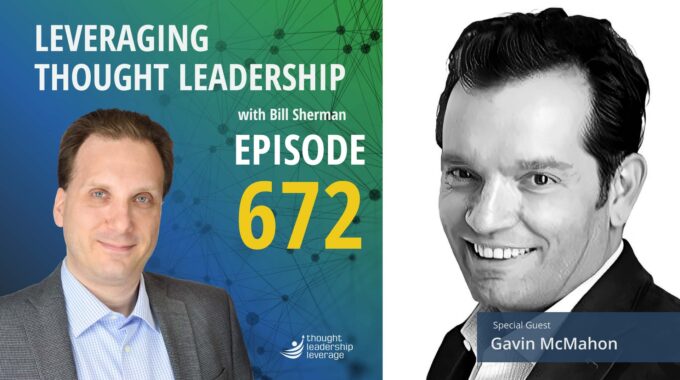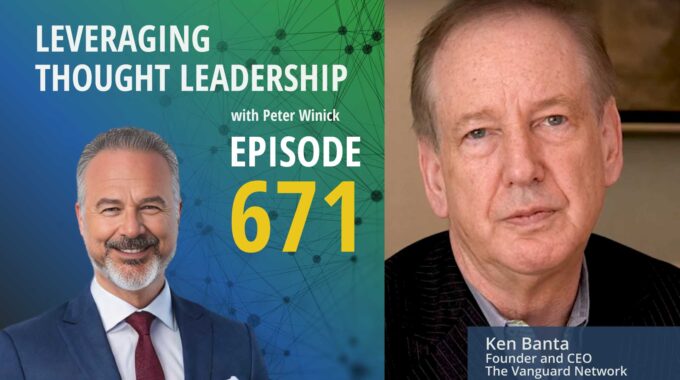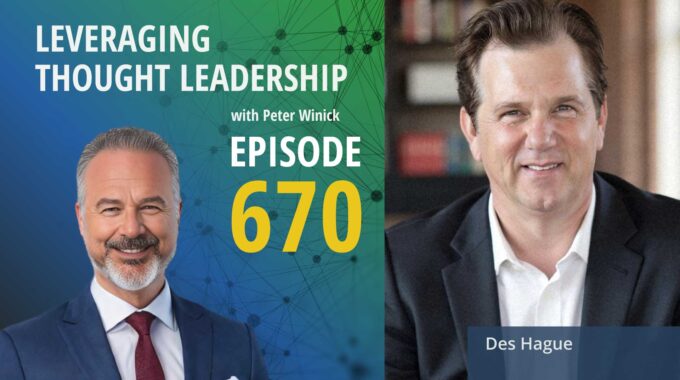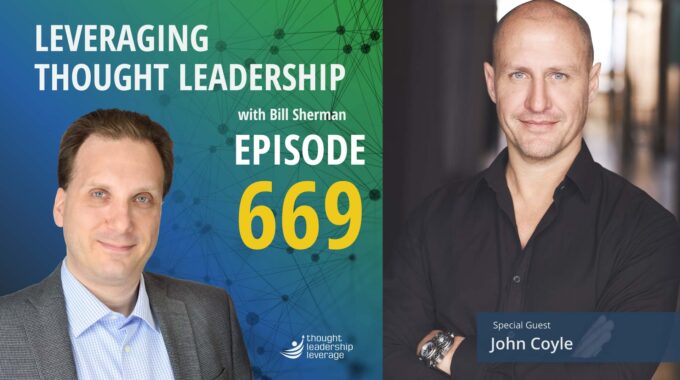How Storytelling Turns Smart Thinking into Real Influence Great ideas don’t win — great stories…
Thought Leadership for Development and Training | Melissa Davies
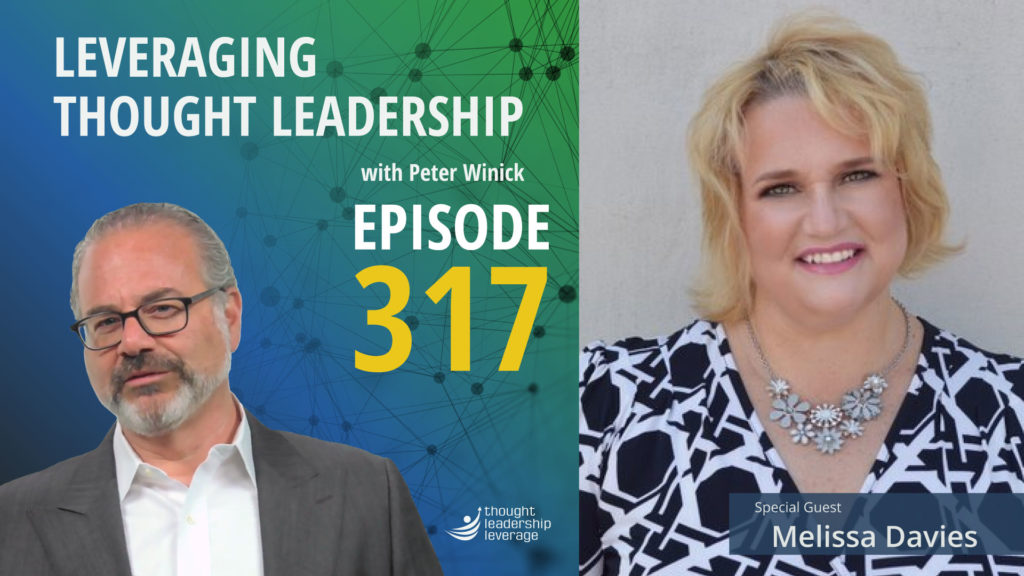
Using thought leadership in facilitating, training, and speaking.
An interview with Melissa Davies about organizational change and where processes and culture fit.
Today’s guest is Melissa Davies, Founder, and CEO of Wieseways Consulting, author of How Not to Act Like a BLEEP at Work, and founding member of the Global Institute for Thought Leadership. She is a Dynamic Facilitator, Educator & Executive Coach with a global perspective.
Melissa walks us through the path she took to become a thought leader. She started as an educator in Canada and the Middle East before landing in the States. Now, she uses her global insights to understand people, gain their trust, and provide a unique perspective to complex problems.
When seeking to improve leadership or teams, we often seek to introduce change. Melissa speaks about being intentional with those changes and using performance management. She explains why being mindful of the culture you are intending to introduce is important. Then, we examine the possible negative implications of those changes.
Our conversation concludes with a look at how COVID-19 has affected training. We will no doubt return to in-person training on some level, but the virtual method is here to stay. Melissa shares how the structure of presentations should change to keep the attention of an at-home audience.
Three Key Takeaways from the Interview
- If you are seeking to introduce thought leadership, find your audience’s common core and understand why they do things the way they do.
- When using thought leadership to build new processes, analyze the positives but also what negative impacts these changes might have.
- An online thought leadership presentation should be concise. Try to keep your presentations to 20 – 25 minutes before moving to discussion and activities.
If you need a strategy to bring your thought leadership to market, Thought Leadership Leverage can assist you! Contact us for more information. In addition, we can help you implement marketing, research, and sales. Let us help you so you can devote yourself to what you do best.
Transcript
Peter Winick And welcome, welcome, welcome, this is Peter Winick, I’m the founder and CEO of Thought Leadership Leverage, and you’re joining us on the podcast today, which is Leveraging Thought Leadership today. My guest is Melissa Davies. Melissa is the founder and CEO of Wise Ways Consulting and a founding member of the Global Institute for Leadership. She’s done lots of interesting things on the facilitation side of the training side, etc. And instead of spending time telling you all about her, I’d rather just talk with her. So welcome. Thanks for coming on board.
Melissa Davies Well, thank you for having me. All really – always good to have a conversation with you.
Peter Winick Oh, thanks. So let me ask you ask you this. You know, so far, I’ve yet to see when the kids knock on my door for Halloween, somebody dressed up in a costume and I go, What is that? They said, I want to be a thought leader. Like, we haven’t seen that yet. Right? I think that’s the day that I’ll be forced to retire, right? We see firemen and princesses and Superman and all that. How did you get here? You know, what was what was the plan or non-plan that said, one day I will be a thought leader?
Melissa Davies Yeah, I’m going to go with the word non-plan. That’s probably it. Yeah. So I was I was born and raised in Canada, and my background is in education. So I was teaching and I spent time teaching in northern British Columbia, and then I ended up teaching in the Middle East. I went to Abu Dhabi and then over to the Philippines and Dubai, and then I finally moved to the U.S. when I got to the U.S., I had and I really had intended to do a life coaching and executive coaching and life had other plans. And so I ended up doing a lot of training for the federal government space for others. And like you, I’m not stupid. I’m be able to put some ideas together and I started to realize that I could do this myself. I didn’t need to work for other companies, so I could be my own thought leader.
Peter Winick So let me stay there. So it’s interesting because a lot of folks. And there’s different levels of things that folks do. There’s so when we talk about facilitation and you sort of double click on that, well, there’s a there’s an army of folks that facilitate other people’s things. I’d say most facilitators are actually facilitating someone else’s stuff, whether that’s cover or you can go on and on down the list there. And then for a subset of them, they realize like, you know what? I got my own thing right. I want to. I want to. I want to sort of play my own music, if you will. And it’s not that we ignore the influences of others. So what was that journey like for you to say? No, this is what I’m about. My stuff is about my style, my how did how did that come to be?
Melissa Davies I think that I started with my own style, which because of my background experience, is often different than what other people bring. Having lived and worked in the Middle East, I do a lot of work now in the states with the DOD community. Mm-Hmm. Have any military background, but I do have a background of being overseas and just being able to accept people where they come from or where they’re at what point in life they’re at and being able to work with folks from that point. So I think for me, what makes me different is just bringing that different experience in that background so that, yes, I will use other people’s material, but I really prefer to use my own and to be my own self and then to be able to go into organizations because we do my team and I do a lot of facilitation and training. But we also will go into organizations and look at where they are and where they’re trying to get and help them craft a plan to get from A to Z via various other points.
Peter Winick So it is one of the differentiators, if you will, the perspective that you’ve gained because going from Canada to the states is a mild form of shock. Very mild, right? Although depending on when you got here,
Melissa Davies Probably a bigger form than you think.
Peter Winick Okay, but the Middle East is a whole different game. So is it that global perspective because when you think about just the norm, when you think about the culture? So you saw a lot of differences and you saw a lot of similarities. So what were the tools that you developed that you were that you either developed because of your experience in the Middle East or you wouldn’t have needed to develop if you didn’t have that experience?
Melissa Davies I think for me, one of the biggest tools is just being able to sit back and watch. And I think that’s important when you go into organizations as well as sitting back and watching. So being what I would say, coming from a level of cultural competence is being able to sit back, watch how people engage, watch what’s going on with them instead of what we always talked about the idea of seek first to understand, then to be simply sitting back and watching and then understanding that people at their core have commonalities, right? We want to be valued. We want to be sure we want to be understood that works in organizations, on teams and cultures, all of that. And so being able to ask people and say, Hey, so tell me a little bit about X or that’s interesting. Help me understand from, you know, I lived in the Middle East where we were able to share in people’s different big holidays and celebrate. We’re not from the same faith. So we’ll say, Well, that’s interesting. Tell me a little bit about why you do that as opposed to what I’ve seen for people in the times as it works. Why do they do that? Well, why don’t you just ask, right?
Peter Winick Instead of the first reaction being, it’s strange. Well, it’s strange to you based on your experience. It’s normal to them. How about how about trying to bridge that? So, so little bit.
Melissa Davies Let me guess there’s been studies that they’ve done where they’ve actually looked at different faiths and drilled them down, and they’re the same core principles.
Peter Winick Right, right. It’s just it’s just sort of evolved different cultures over time. So let me ask you this one of the things that leaders often struggle with is, you know, typically they’re smart. Typically they’re adaptable. Typically, they can read the tea leaves. So there’s a lot of typical. But part of the downside of that, it’s hard to articulate or communicate sort of what the what the differential, you know what the core is. So we call that, you know, sort of solve for X. So if I were to say to you, Hey, Melissa, you have got some folks I wanna introduce you to, but what is the gist? What’s the essence? What’s the, you know, I got to tell them that Melissa is the X woman. It’s one of the things she does better than almost anybody. I know. How would you respond to that?
Melissa Davies It’s an interesting question. I think for me. People trust me. People will. I will do sessions and people will tell me things and I’ll think, Oh my goodness, I can’t believe you told me that. But they will say, just as my mother would have said, they open up all of their guts rumble out. OK, I have this ability for people to trust me to open up and to be authentic about what’s really going on for people to feel hurt.
Peter Winick But I want I want to say on the trust thing for a minute so we could push on trust and say two ways I can take that number one. It’s a trait of yours. That’s a superpower, right? You’re someone that that gets trust at a quicker pace than others. And or is that a capability that you can teach in others? Because I think that’s sometimes where there’s a split in folks that as a group, as a great consultant, I have these traits right, as a great trainer or a subset of my intellectual property can be ported into different modality to develop capabilities in trust. They’re not always the same. So how is this more teachable or is it more part of your DNA or both?
Melissa Davies So for me, it’s part of my DNA. OK, do I think you can teach people if they authentically want to learn how to do that? Yes. Each of them you have to teach people the need. So removing judgment. So I learned a while ago, a long time ago, the judgment is not for me. I don’t need to. I mean, if I want to be a consultant, if I want to come in and help you, I’m the sounding board. I’m the person that creates it, not with the department.
Peter Winick It takes a level of. Oftentimes, I call it the curse of the expert. Well, you can just you go in, you sit there, you read a room, Oh yeah, this and this and this, and there’s a power dynamic here and you’re like a hundred miles an hour. Like, how did you do that? And the honest answer, I have no idea until you stop because it’s happening in a part of your brain that’s just very tuned in, right? And then you like, actually? Yeah. So the first thing is when we talk about trust with you, the first thing is suspend judgment. OK, great. So you’re able to sort of stop and go, Hmm, I wonder how it is. I do that right? I wonder how it is that I’m able to do that. I think a lot of thought leaders, not just not just in the trust space, in any space, go, huh. I think it’s just my charisma, and they haven’t really forced themselves to stop every step of the way. There’s things that we do that if you break them down into their tiny, tiny, tiny pieces, we don’t even realize that we’re doing all those things.
Melissa Davies So I am very purposeful about suspending judgment when I, you know, I joke I, I tend to be funny in front of people, in front of classes, so there’s a way of putting people at ease. Hmm. Joke about myself and not in a self-deprecating way, because I don’t think that sets the right tone. But I do think that we can joke about it in a space that is safe. If you go back to Lindsey on his work, the bar, you know, trust is the bottom of the pyramid. Mm hmm. So if I don’t trust you, I don’t share those things with you. I don’t share my good ideas. I also don’t share that either. That idea you’re working on is half baked. We got a problem. So I think being able to create that create that foundational space of trust is critical. And I teach people to do it. Yes, there are things that you can teach folks to do, but when I come into a room or into group. You know, my Myers Briggs Typekit that I’m going to – I’m an INFJ – I like to get into the middle in that and to get in the middle of the team and ask the questions and listen and give and take on that because I think that a lot of organizational change is not necessarily process change, but also culture from people. And so leadership and all levels of leadership and all people they’re needing, you know, being able to ask for feedback and accept feedback in a way that is it. Well, the reason I do that is and great, congratulations. If you were trying to build any level of trust, you just threw that away.
Peter Winick I think that if you’re enjoying this episode of Leveraging Thought Leadership, please make sure to subscribe. If you’d like to help spread the word about our podcast, please leave us a review and share it with your friends. We’re available on Apple Podcasts and on all major listening apps, as well as at Thought Leadership Leverage dot com forward slash podcasts.
Peter Winick But talk about I think that that process and culture tension, if you will, because some of it is. There are people that see the world through the lens of systems and processes, and that’s the answer to everything. Let’s just Six Sigma the heck out of this thing. And voila! And then there are other folks that are a little bit more, you know, I would say Kumbaya, but more. Let’s get the culture right and everything also work out. And I think the answer is no, you’re both from the culture. People need to understand and respect the process and the process. People need to understand and respect the culture because it’s not an either or it could be another word for short term, but it’s not going to be long term and sustainable. So how do you sort of thread that needle of the what’s the sweet spot for process and culture?
Melissa Davies Interesting, so I think there is a there definitely is a sweet spot, there is that recognition that if we’re going to put in a new process or change, it also has to be managed. And performance management is part of culture. Giving people creating a safe space or for people to try new things and make a mistake. And because that’s how we grow, right, we make a mistake when you put a system in.
Peter Winick How is it that you might think about, OK, so the system is going to make this this doing this task ABCD or serving this? It’s going to make something more efficient, better, less waste easier or whatever, whatever. How do you sort of pausing? I wonder if there’s going to be intended or unintended consequences that might run up against our culture? And how can I think about that? Is somebody going to lose power or prestige by installing the system? You know, we can’t information hoard anymore. How do you play that out? Or do you
Melissa Davies think you have to be purposeful and intentional about it? OK. You just sit as a group and talk about what is the. What are the pluses that come from this and how do we capitalize on those? And then also, what are the intended possible negatives? Are we outsourcing somebody or are we removing somebody’s capabilities? Are we pushing people to learn new things at the end of their career when some of them are like, Yes, let’s we do that? Or, you know what? I want short time. I get six months and let me just ride this out again. And who do we have on our team that this is their strength, that maybe we haven’t? We haven’t utilized that to this point, but this is our new champion. So let’s get to there, you know, let’s help them grow that feather in their cap, becoming the new champion on that. And these are ways we can tap into people’s unknown strengths and we can make them the expert when they were hoping for some, some way of standing out from the crowd. I think we have to be intentional that not just because you’re in a leadership role doesn’t mean you’re the best person to lead this particular change effort.
Peter Winick Got it! So what are what are the things when you think back now when you started as a thought leader and said, Oh my God, I can’t believe I actually did that. I can’t believe like I thought that would work. What are the things that you know if you were to speak to you minus, you know, X number of years, what wisdom would you bestow on a 15 year younger Melissa? That’s really interesting. Based on battles, you know.
Melissa Davies Not everybody wants to change.
Peter Winick Yeah. OK.
Melissa Davies Just because you see value in this and you think people are important. Speaking to me that you think people are so important to organizations because I really do believe they are. Not everybody is in tune with you. So something -.
Peter Winick I like that because, I actually thought at one point when I was single that there was an inverse relationship to the amount of self-help books someone had and their mental well-being. It was like the more self-help books you bought, the more the crazy train had arrived, you know, so it didn’t mean that they didn’t have the information or the data or the process or the, you know, seven different viewpoints. But there’s a difference between reading about doing A, B, C and D and actually doing it
Melissa Davies Right, right? How many books? Well, that’s not even self-help, but how many leadership development or organizations about what books do you have on the shelf that are three chapters in with a folded corner and like ten chapters not done?
Peter Winick Yeah. Right, right, right.
Melissa Davies So not everybody is eager about this as the rest of us. That’s the first one. And I think to the. Never underestimate. The power of performance management or following through or ensuring this, because I see a lot of things that happen where the lower level employees and I hate to use that term, but you -.
Peter Winick Right. Or whatever.
Melissa Davies You’re front line, folks, they’re doing these things, they’re working on communication skills. We’re talking about emotional intelligence. We’re really trying these things are trying to implement them. But then they hit their second level manager. Hmm. Or the C-suite or the other leadership parts the organization. And it’s just like. But what if I have to do it, why aren’t they trying these things? You know, we talk about communication skills and then let’s talk about, you know, when I teach mentorship and coaching and leadership development. Let’s talk about really good ways of question of using these what I would call data rich questions. We do them as consultants when we go in to do it organizational. But let’s use those same types of questions when we’re doing performance management. So hey, Peter, tell me two things you’re working on right now that are really being successful where you feel right. Or at the end of the year, tell me two things that I’m doing that are helping to add value to the work you do and what’s one thing I could do to support you differently? Got it. Let’s use those questions because the language has power.
Peter Winick You know, I love that, so as we as we start to wind down. Any thoughts or reflections on the changes we have gone through, and we’ll continue to go through? So some are temporary, some will be permanent sort of in this post-Cold world in terms of how we serve our clients in terms of culture. Anything that bubbles up to the top to you of, yeah, this this thing, I think that that was imposed on us will now stick and it’s good and this thing will. Can we get to get back to the way we used to do things?
Melissa Davies So I will tell you there in my mind, there’s nothing better than a great in-person training session. The energy, the connection you get, that’s wonderful. And I look forward to going back to those. I can guarantee you that they’re not going to happen for everybody that organizations now have thought, Oh, hang on, we can do a little bit of hybrid on this. This is going to be OK. And so one thing I’ve learned over it is about the cameras letting people. And I say to folks at the beginning, if you’re ever in my class, you’ll hear me say, Hey, this is a no judgment zone. Turn the camera on. I don’t care what you’re wearing as long as I’m from the waist up and let’s see the grandchild, I don’t care. Judgment Zone. And I think we really have to walk that talk and you’ll hear me in class sometimes say, Hey, the cat walked across the back, what’s the cat’s name? Yeah. Really? Try to model that, and I think that that’s here to stay. I don’t think that that we are going to go back to everything. Being a person. I think that work, the genie is out of the bottle.
Peter Winick Yeah. And I think, like you said, you know, there’s nothing that replaces the in-person piece. But I think, you know, quite frankly, a lot of in-person training was awful and didn’t take any advantage of the fact, like, wow, you’ve got 25 human beings that have dedicated time to be in this room together. Why are you, you know, vomiting PowerPoint on me? Like, what are you doing? You know? And I think we’ve got to be more thoughtful about. I don’t think it’s going to go to zero. The trend lines pre-COVID were pretty bad for the workshop experience, and I think maybe one of it is that the bar is going to be higher. OK, I’ll jump on that plane, and I’ll go back out and I’ll go be there. But you better really blow me away in a good way. I’m not going to tolerate mediocrity
Melissa Davies well in academic practice, tells us. Max twenty to twenty-five minutes of lecture or discussion, you get into activities so you should not be talking at somebody for an hour. I would say to folks, you don’t want to hear me talk, could you for an hour? And I don’t want to hear my voice doing that either. So only the twenty-five minutes we do that now, what I started doing online is a similar, but it’s more of a 50 and ten. Every 50 minutes you get a ten-minute break. Yep. We have to change that structure, but everything that would have been a tabletop activity is an activity in class, right? We just oh, look, now I have a captive audience to be a webinar. That’s not my egg and I don’t want and I personally, I can’t cope with being in that. So I would never want to subject you to something that I don’t want to be a part of myself.
Peter Winick Right. And the redefining what interactivity and collaboration is in a remote world, right? So breakout room, their breakout rooms that are done well and the breakout rooms that are awful, if it’s just the technology, it’s useless. It’s got to be rooted in. And here’s three questions to ask one another. And you know, it all goes back to that, that very solid instructional design and the academic rigor. And OK, so you put us in a room, and we stare there and the instructions are vague and seven minutes and.
Melissa Davies That’s right. Now what exactly? I mean, I think going back to that, but and again, modeling what you expect to work, modeling what you want to see from people and still creating that trust. Even when you’re doing meetings and things online, you’re sure
Peter Winick This has been great. I thank you for your time and popping in and sharing your global experience with us. A little bit of a different twist on things. So thank you so much, Melissa.
Melissa Davies Thanks, Peter. I appreciate you having me on the show.
Peter Winick To learn more about Thought Leadership Leverage, please visit our website at ThoughtLeadershipLeverage.com to reach me directly. Feel free to email me at Peter at ThoughtLeadershipLeverage.com and please subscribe to Leveraging Thought Leadership on iTunes or your favorite podcast app to get your weekly episode automatically.



